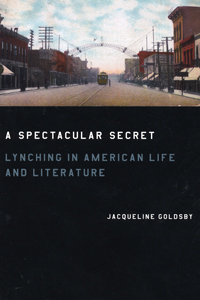Goldsby mines literary repository, ‘reading history out of texts’ to write about America’s history of lynching
By Josh SchonwaldNews Office
 | |
Jacqueline Goldsby, Associate Professor in English Language & Literature, received two honors last month for her 2006 book, A Spectacular Secret: Lynching in American Life and Literature.
At the Modern Language Association’s convention last month in Chicago, Goldsby received the William Sanders Scarborough Prize, which is awarded annually for an outstanding scholarly study of black American literature or culture. Also, in December, Goldsby learned that the book was named a finalist for the American Studies Association’s Lora Romero First Book Prize.
“It’s extremely gratifying to win this recognition from my peers in African-American literary and cultural studies,” said Goldsby of the Scarborough prize. Moreover, Goldsby added that the MLA’s award was particularly meaningful because it represents an important change in her field. “African-American literary criticism has a long and rich history,” she said, “but it wasn’t always acknowledged by institutions like the MLA. The Scarborough prize affirms the centrality of this field in American literary and cultural studies,” she said.
Goldsby is only the sixth recipient of the prize, and Chicago’s first winner.
In citing A Spectacular Secret, which was published by the University Press, the American Studies Association praised Goldsby for producing an “incredibly critically sophisticated work, ground-breaking for its discussion of violence as a critical discourse vis-à-vis its focus on lynching in American life and literature.”
Goldsby traces the origins of her book to her undergraduate years in the early 1980s at the University of California, Berkeley. While researching a bachelor’s honors thesis about racial violence’s effects on Southern family relations, Goldsby encountered the “missing history” of lynching in the United States.
There was an astonishing number of lynching deaths in the United States. “Roughly two per week in the 1890s,” she recalled. Yet, Goldsby found there was such a dearth of scholarship on the subject; the most comprehensive history of lynching dated to the 1930s. That raised many questions for Goldsby. “In the wake of Emancipation, how could black lives be handled so cheaply, and wasted so ruthlessly?”
With little scholarship on the subject, Goldsby began to regard literature as a valuable, unmined repository of one of the darkest—and seemingly overlooked—periods in American history. As an American Studies graduate student at Yale University, Goldsby began to methodically examine the representation of lynching in American literature.
She found that there were many more literary accounts of lynching than scholars had previously acknowledged, and that in nearly every text she read, authors were experimenting with narrative and poetic forms when representing the violence. ”Novelists turned to the short story. Poets focused on the ballad or the sonnet. Playwrights developed one-act dramas. Why?” Goldsby wondered. She also noticed another trend: Cultural observers fretted over the fact that lynching emerged in a modernizing America. “The 1880s and 1890s saw the country recover from the Civil War—the economy was expanding because we had shifted to a fuller-scale industrial market; the nation’s boundaries extended to both coasts; cities were booming; the professional and middle-classes were thriving,” Goldsby said. “But in the midst of all this progress, white mobs were killing black people in the most heinous ways. What, then, did modernity mean?”
The culmination of her research is a highly narrative work that charts the history of lynching from the 1880s to the lynching of Emmett Till in 1955. Like a literary detective, Goldsby uses several means to tell her story. But her method includes an important twist. “Instead of reading history into literary texts,” she said, “I read history out of them.” Starting with the scenes of mob violence as they are rendered in the literary works, A Spectacular Secret analyzes and reconstructs the mob murders and assaults that inspired the anti-lynching pamphlets of journalist Ida B. Wells-Barnett, the novels of Stephen Crane and James Weldon Johnson, and the poems of Gwendolyn Brooks. Telling the social and cultural histories this biographical evidence suggests, Goldsby returns to literary texts, arguing that their formal features register how the authors’ perceived the violence as a modern phenomenon.
“To take just two examples,” Goldsby explained, “Ida Wells’ parodies of news writing styles implicate how the secularization of knowledge at the turn of the 19th century fostered lynching’s popularity. Stephen Crane’s refusal to obey his publisher’s demands to expand The Monster from a novella to a novel-length work uncovers why the rise of corporate capitalism encouraged Northern liberals’ indifference to these mass murders.”
In recent years, there has been a groundswell of scholarly efforts to examine the history of lynching. But, A Spectacular Secret differs from those books, Goldsby said, because it turns to imaginative literature to tell a different but nonetheless “real” history of lynching.
Later this quarter, Chronicle writer Josh Schonwald will interview Goldsby, who is on leave this year researching her latest work, Birth of the Cool: African American Literary Culture of the 1940s and 1950s. The interview will explore with Goldsby A Spectacular Secret: Lynching in American Life and Literature and Birth of the Cool, as well as the “Mapping the Stacks” project, which is documenting the African-American heritage of Chicago’s South Side.
![[Chronicle]](/images/sidebar_header_oct06.gif)